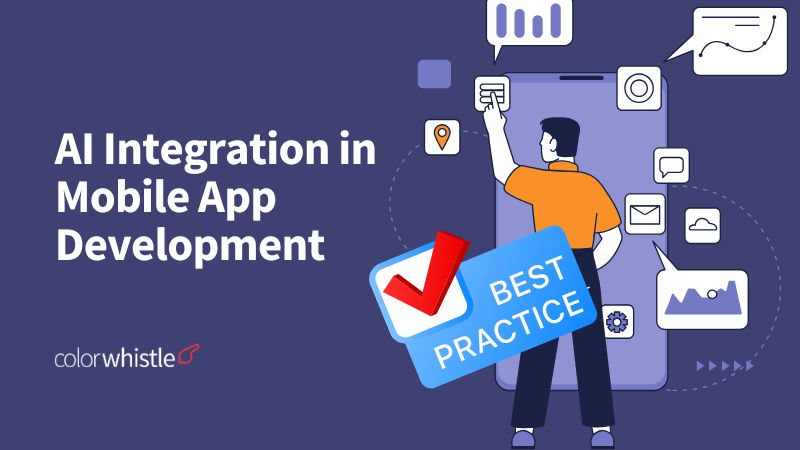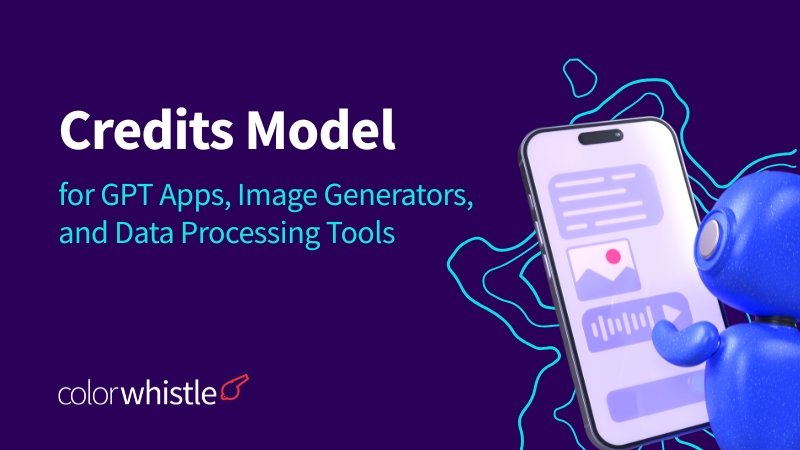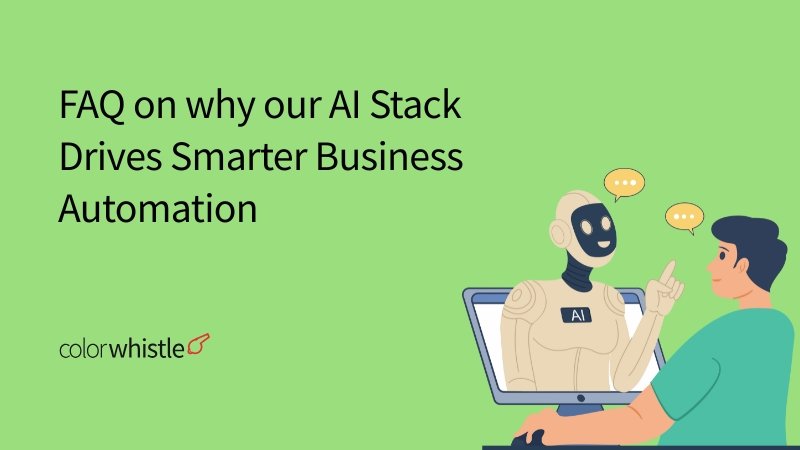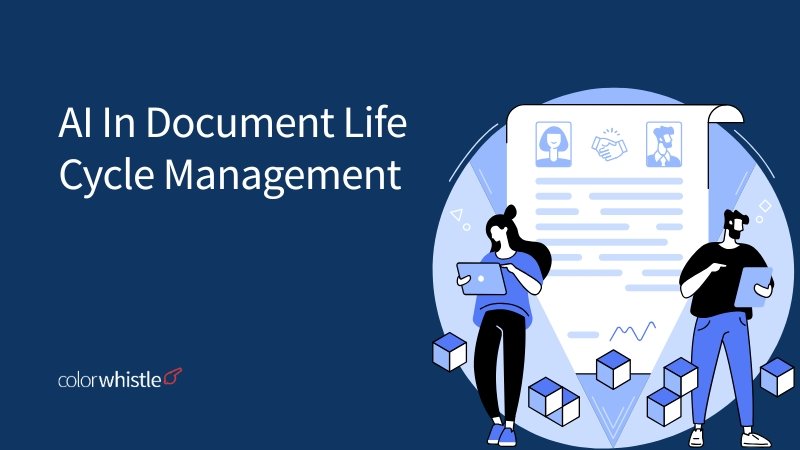Imagine two coffee shops. One uses a simple cash register, and the other leverages AI to predict your favorite drink and offers personalized deals. Which shop are you more likely to visit? That’s the power of AI in today’s mobile app landscape. AI is no longer a futuristic concept; it’s the driving force behind smarter, more engaging user experiences.
In fact, according to a recent study, 70% of consumers expect personalized mobile experiences. This blog is your comprehensive guide to navigating this AI-powered revolution. We’ll equip developers with the best practices for seamless AI integration, ensuring your apps not only meet but exceed user expectations, driving performance and long-term growth for any mobile app development company.
Did You Know?
According to a recent survey, 80% of businesses are expected to use AI technology by 2025, and the integration of AI into mobile apps is increasing exponentially
Understanding AI’s Role in Mobile App Development
AI is crucial in making mobile apps better by improving how they work and how users experience them. It helps apps do things that feel like human thinking, like learning from information, understanding everyday language, and recognizing pictures. When AI is added to mobile apps, they can provide more personalized and effective services, which makes users happier and more involved.
Types of AI Used in Mobile App Development
Several types of AI are commonly used in mobile app development:
Machine Learning (ML): Let apps learn from data and make predictions, getting better as they receive more data.
Natural Language Processing (NLP): Helps apps understand and create human language, making user interactions smoother.
Computer Vision: Assists apps in understanding visual information, which is helpful for things like recognizing images and augmented reality.
Chatbots and Virtual Assistants: Offers immediate support and personalized experiences, improving user satisfaction.
Examples of AI-Driven Mobile Applications
AI-driven mobile applications are widespread and diverse:
- Fitness Apps: Offer personalized workout plans and health recommendations based on user data
- Shopping Apps: Provide product recommendations and personalized offers based on user behavior and preferences
- Travel Apps: Use AI to suggest travel itineraries, offer real-time translation, and provide personalized travel tips
- Finance Apps: Use AI for fraud detection, personalized financial advice, and automated investment management
Understanding these AI technologies and their applications is essential for developers looking to integrate AI effectively into their mobile apps.
Also Read
Best Practices for AI Integration in Mobile App Development
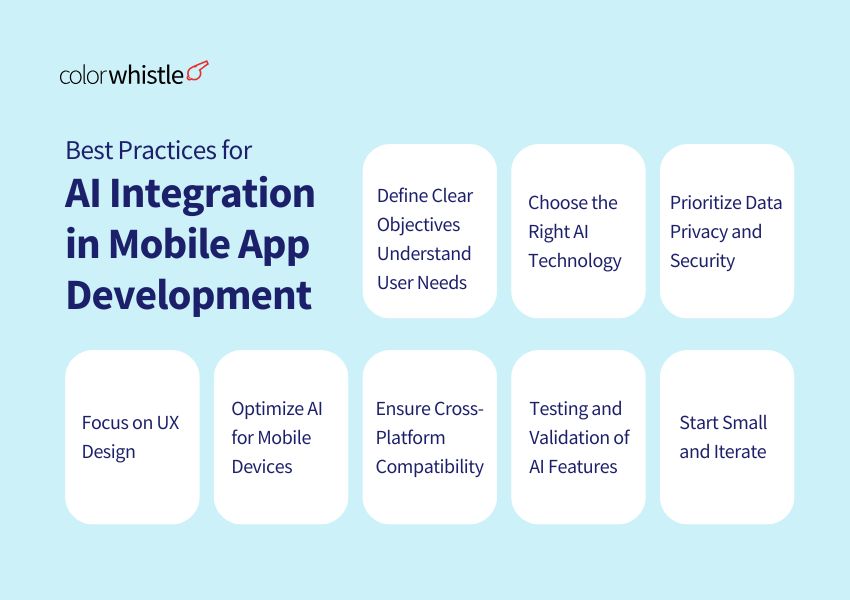
1. Define Clear Objectives
Before you begin your AI integration journey, you need to define clear goals. This requires two key steps:
- Identify the specific problems AI can solve: Pinpoint user pain points or app limitations that AI can solve. For example, can AI improve user engagement, automate tasks, or personalize recommendations?
- Set measurable goals for AI integration: Set quantifiable goals to track the success of your AI implementation. This could include increased user retention, higher conversion rates, improved customer satisfaction scores, etc.
2. Understand User Needs
AI integration should always be user-centric. This requires:
- Conducting user research to understand pain points and preferences: Gather feedback through surveys, interviews, and usage data to understand what users really want from your app.
- Ensuring AI features align with user expectations: Design AI-powered features that seamlessly integrate into the user experience and truly address user needs, without unnecessary complexity or gimmicks.
3. Choose the Right AI Technology
- Overview of AI technologies: Learn about different areas of AI, such as machine learning (ML) for predictive analytics, natural language processing (NLP) for understanding and generating human language, and computer vision for image and video analysis.
- Select the appropriate AI model based on the app’s requirements: Select the specific AI model that best meets the intended functionality of your app (such as a recommendation engine for personalized suggestions, a chatbot for customer support, or image recognition for visual search).
- Consider pre-built AI solutions vs. custom AI models: Evaluate whether a pre-trained AI model (often offered by cloud providers) meets your needs or whether you need to develop a custom AI model tailored to your specific data and requirements.
Also Read
4. Prioritize Data Privacy and Security
Protecting user data is paramount when integrating AI. This requires:
- Ensuring compliance with GDPR, CCPA, and other regulations: Ensure compliance with GDPR, CCPA, and other regulations. Comply with all relevant data protection laws and regulations to maintain user trust and avoid legal issues.
- Using encryption and anonymization for sensitive user data: Use encryption and anonymization for sensitive user data. Use strong encryption methods to protect data in transit and at rest, and anonymize sensitive information whenever possible.
- Implementing secure AI models to prevent breaches: Implement secure AI models to prevent breaches: Select and implement AI models that are designed with security in mind to reduce the risk of data breaches and unauthorized access.
5. Focus on User Experience (UX) Design
AI integration should enhance, not complicate, the user experience. Key considerations include:
- Importance of intuitive interfaces: Design user interfaces that are easy to understand and navigate when interacting with AI-powered features. Don’t overwhelm users with complex AI jargon and controls.
- Seamless integration of AI functionalities into the app’s design: Seamlessly integrate AI features into your existing app design for consistent, natural user flows. AI should feel like a helpful assistant, not an intrusive presence.
6. Optimize AI for Mobile Devices
Mobile devices present unique challenges for AI implementation. Optimizing for these constraints is crucial:
- Address challenges like limited processing power, memory, and battery life: Recognize the resource limitations of mobile devices and develop AI solutions that are efficient and have minimal impact on performance and battery consumption.
- Use lightweight AI models (e.g., TensorFlow Lite, Core ML): Use optimized AI frameworks such as TensorFlow Lite and Core ML designed specifically for mobile to reduce model size and improve performance.
- Leverage edge computing to process data locally on the device: Move computing from the cloud to the device itself (edge computing) to reduce latency, improve privacy, and reduce dependency on network connectivity.
- Optimize AI algorithms for faster performance and reduced latency: Refine AI algorithms to minimize computational complexity and improve response times for a smooth, responsive user experience.
7. Ensure Cross-Platform Compatibility
Reaching a wider audience requires cross-platform compatibility:
- Optimize AI for Android, iOS, and other platforms: Tailor your AI implementation to the specific requirements and capabilities of each target platform (Android, iOS, etc.) to deliver optimal performance and a consistent user experience.
- Use frameworks that support multi-platform AI deployment (e.g., TensorFlow Lite, Core ML): Using AI frameworks such as TensorFlow Lite and Core ML that offer cross-platform support can simplify development and deployment across multiple operating systems.
8. Testing and Validation of AI Features
Thorough testing is essential to ensure the quality and effectiveness of AI-powered features:
- Importance of rigorous testing for accuracy and reliability: Conduct extensive testing to ensure the accuracy of AI predictions and the reliability of AI-driven features. Test with diverse data sets and edge cases to identify potential biases or vulnerabilities.
- Continuous monitoring and updates post-deployment: Monitor AI performance after release to identify issues or accuracy regressions. Implement a process of continuous improvement and updates to maintain optimal performance and adapt to changing user needs and data patterns.
9. Start Small and Iterate
A phased approach is often best for AI integration:
- Begin with core AI functionalities: Don’t try to implement everything at once. Start with a few key AI features that address the most critical user needs or app limitations. This allows for focused development and testing.
- Gather user feedback for continuous improvement: Collect user feedback on the initial AI implementations to understand what works well and what needs improvement. Use this feedback to iterate and refine the AI features over time, ensuring they meet user expectations and deliver real value.
Also Read
Wrapping Up
To stay successful in the fast-changing world of mobile app development, it’s important to keep learning and adapting. By following the latest AI trends like generative AI, voice assistants, and augmented reality (AR), developers can find new ways to connect with users. Trying out these new technologies and being open to improving AI strategies based on user feedback and market needs is crucial for staying competitive and creating exciting mobile experiences. Using AI is now essential for building the next wave of successful mobile apps.
Swing by our ColorWhistle page to dive deep into our cutting-edge web app development services. For a touch of human expertise, drop us a message or give us a ring at +1 (919) 234-5140, and we’ll get back to you shortly.
What’s Next?
Now that you’ve had the chance to explore our blog, it’s time to take the next step and see what opportunities await!

